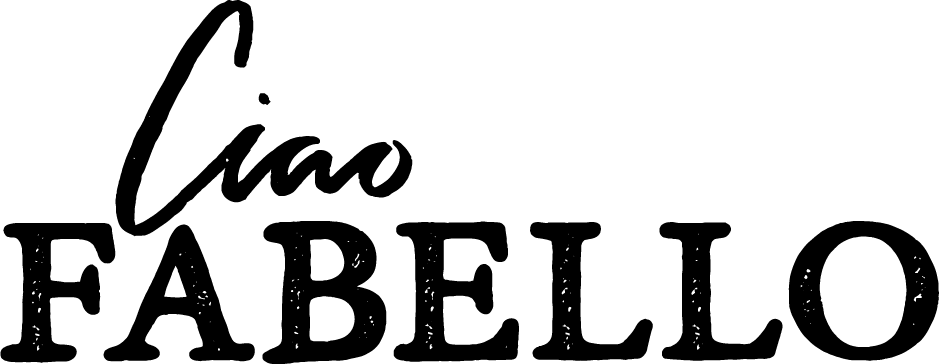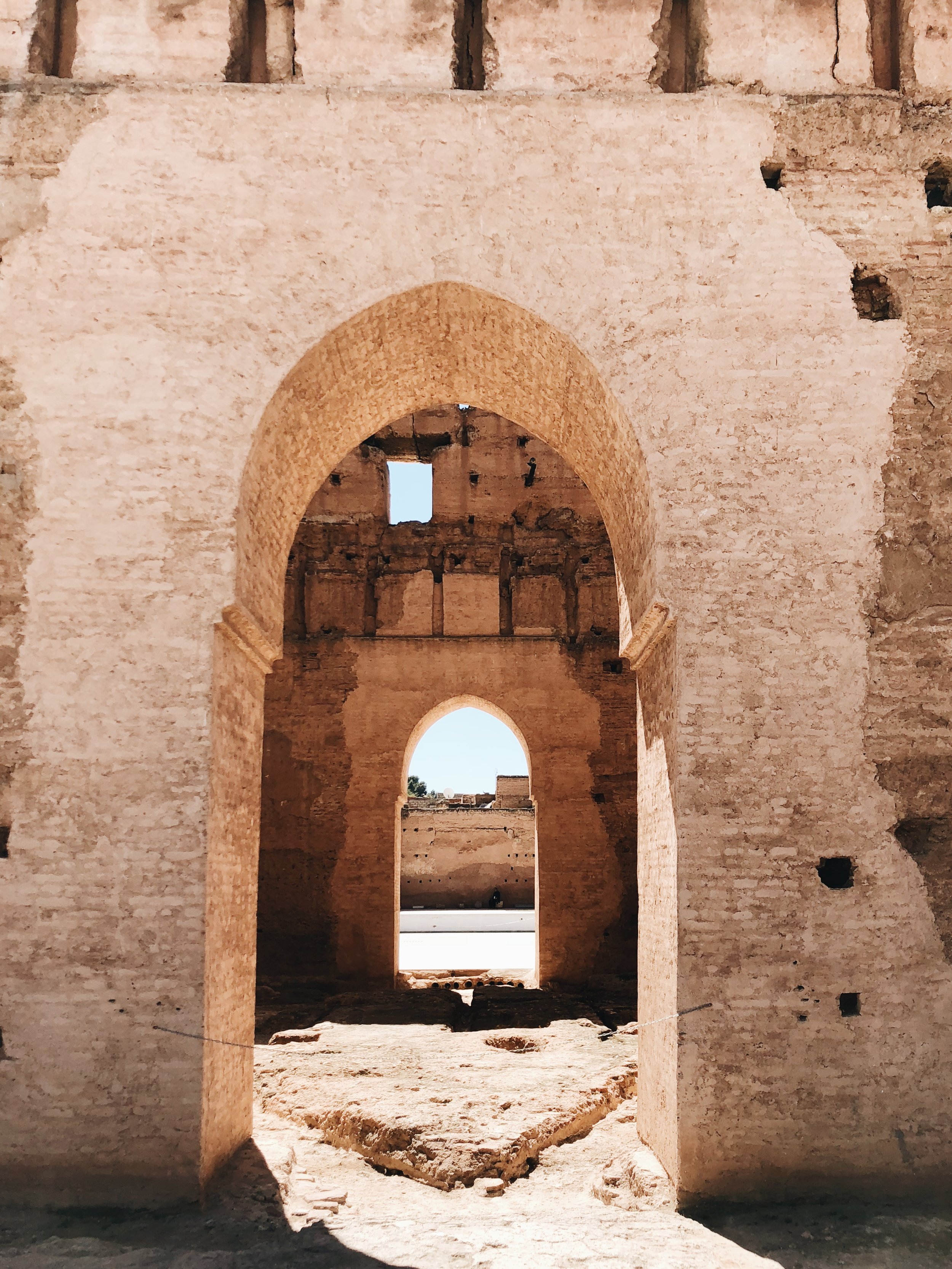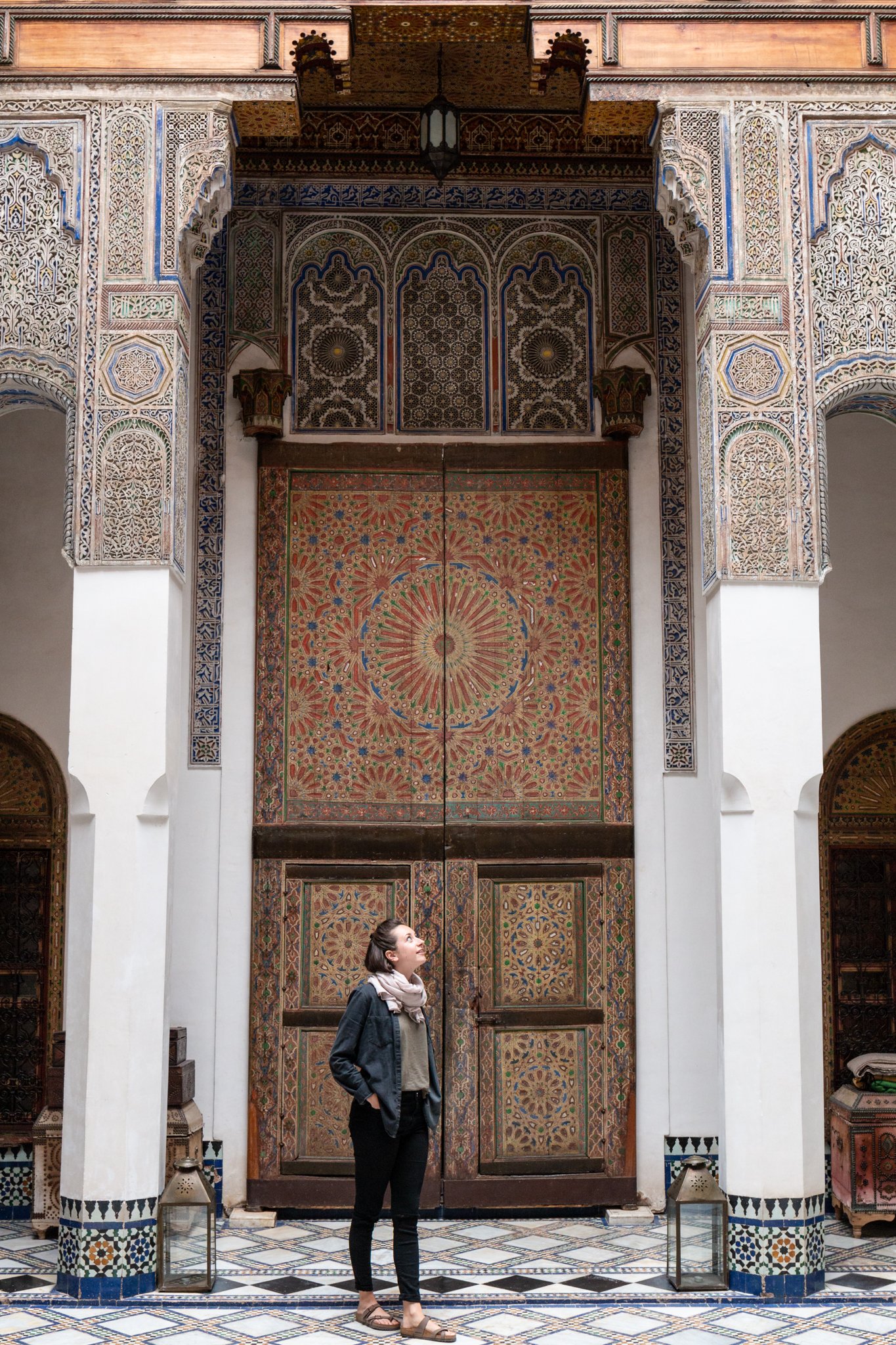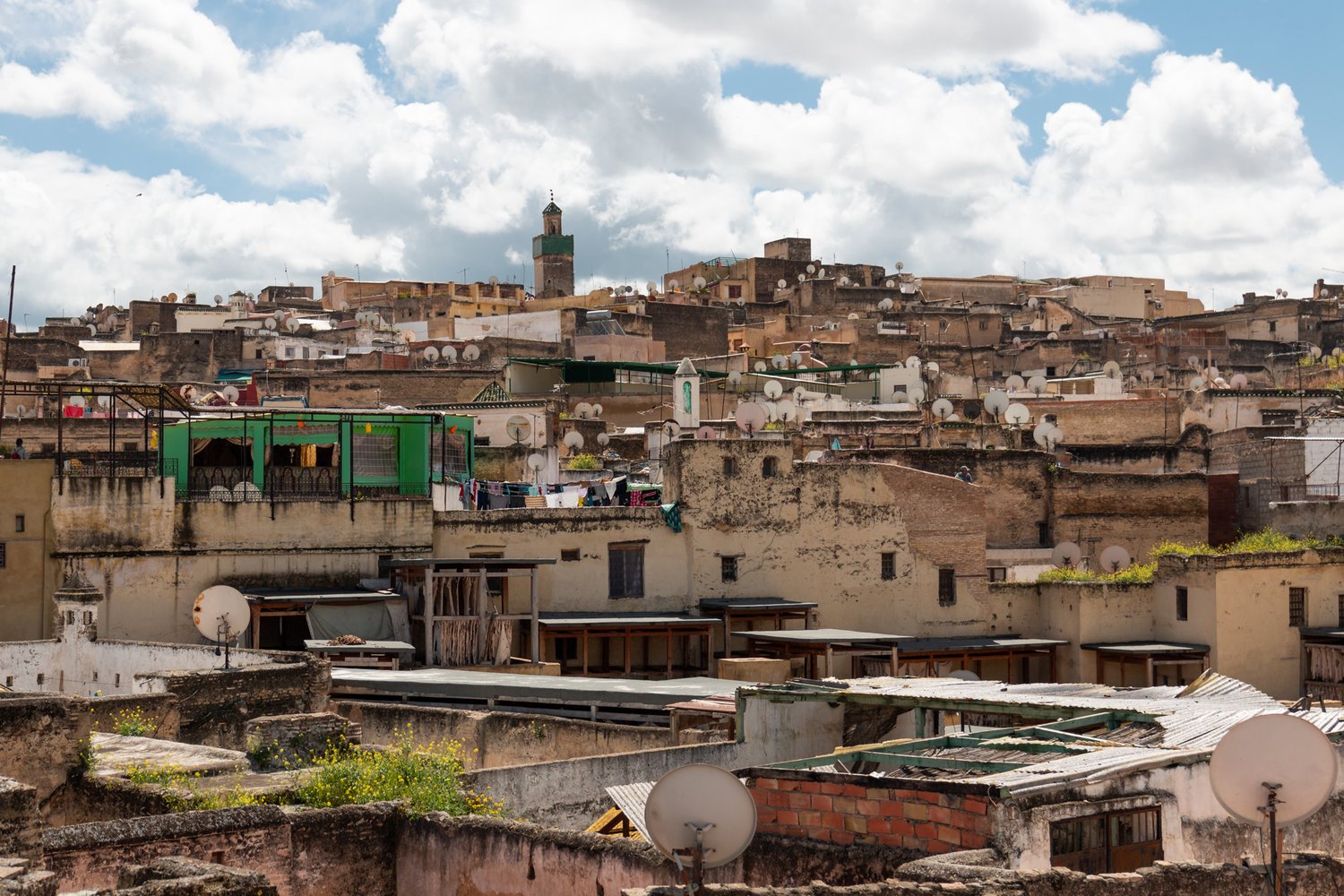Road Trip, Morocco
In our three years of traveling from London, we’ve more or less stuck to what we’ve known: Europe. But more recently we’ve been itching for something different, especially as we’ve started to feel complacent in our comfort zone. Our travels have been missing the adventurous mystique they had in the beginning when we didn’t really know what to expect or what we were doing. Britt had been thinking about Morocco for the past couple of years, and it seemed a reasonable first jump outside Europe our comfort zone, so our first big trip of 2018 brought us to Morocco for 10 days—3 in Marrakech, 4 on the road to and from the Sahara, and 3 in Fez!
Riads—traditional homes built around open courtyards—are the best kind of accommodations in Morocco’s major cities for those desiring to stay right in the medina (Arabic for “city”, but in this context referring to the old Arab walled area of North African cites). They range from basic to luxury, and with travelling costs quite low in Morocco compared to western Europe, you don’t have to spend a lot to get a lot. We stayed in the Sabba Junior Suite at Ryad Dyor, located in the quiet northern end of Marrakech’s medina. We were introduced to Moroccan hospitality when, upon arrival, we were treated to mint tea (which became a staple throughout the trip) and pastries and shown around the riad’s courtyards and roof terrace. The staff at the riad offered lots of advice on where to go, what to see, and how to detect and avoid common scams.
Anyone that spends even a minute online or in guide books reading about travelling to Morocco will find lots of advice about safety, security, and etiquette. Indeed, for those like us who have only barely glimpsed non-Western tourism (Sarajevo in Bosnia probably being the closest for us), places like Morocco can be a shock: the call to prayer five times a day, sights of crippling poverty, chaos in the streets, pushy vendors and shop owners, kids telling you streets are closed or off limits—it’s almost impossible to stop for more than 5 seconds to look at a map without being accosted by people whose intentions aren’t usually kind!
But don’t let the fact that Morocco is different and oftentimes overwhelming stop you from visiting. In fact, that’s all the more reason to have a look for yourself! After all, we wanted to visit to push ourselves out of our comfort zone, and by default that meant things would sometimes be difficult. There were a handful of things that helped us cope which we’d recommend to anyone planning to visit:
Learn some basic Arabic. Our most used phrase by far was la shukran (“no thank you”).
Be confident but friendly. Shop owners can be aggressive, but that’s their style. If you’re not interested, tell them that in a straightforward manner, but there’s no reason to get upset at them. Keep a smile the whole time!
Offset the chaotic energy of the medina with the tranquility of your riad and some of the city’s sights (many of the museums and gardens are beautiful respites from the hustle and bustle outside).
Walk on the right in the crowded alleyways of the medina and let motorbikes use the middle of the road. Once you find the rhythm and order of Marrakech’s chaos, it becomes much more enjoyable.
Use the Marrakech Riad travel guide app. The app has a detailed map of the medina (which tracks where you are if you have GPS enabled) and a handful of helpful articles on getting the most out of the city.
Be prepared to haggle for anything and everything in the souks. There are many guides online to haggling in Morocco (including in the Marrakech Riad app), so get reading!
Both men and women should dress conservatively. Rico wore long pants and a t-shirt at a minimum. Britt was covered wrist to ankle with loose-fitting clothing at all times. Regardless of your personal views on this convention, you are a guest in another country and should follow basic etiquette. If anything, it will help shield against the worst abuse. We saw on multiple occasions groups of women dressed in inappropriate clothing, and in each case they were the targets for the worst harassment.
This is by no means an exhaustive list, but these tips helped us cope with the differences and enjoy our time to the fullest. Lastly, we’re aware that our experience might be different from others. For one, we visited as a man and a woman who kept close to each other at all times. We read a lot about harassment toward women, but Britt did not experience nearly anything as bad as she was prepared for. Our preparation as per the points above and the fact that she was with a man no doubt helped.
Marrakech
OK, OK, let’s get to it! Unfortunately, the famous Ben Youssef Madrasa was closed for renovation, so our riad suggested we visit Dar El Bacha Musée Dea Confluences instead. The museum was not yet officially open, but was allowing visits for people who knew enough to go—this probably explained the lack of crowds! The museum was our first view of the intricate detail of Moroccan architecture, something that blew our minds time and time again over the course of the trip. The serene courtyard dotted with orange trees also served as a restful break from the streets.
We left the medina walls for visits to the Yves Saint Laurent Museum and Jardin Majorelle. The queue for tickets to the garden was very long, so we bought combination tickets from the Yves Saint Laurent Museum, which has much shorter queues, allowing us to skip the line for the garden. After a quick museum visit, we wandered the gardens to seek out viewpoints from which to appreciate the villa’s deep and vivid Majorelle blue color. Check out the 33 Rue Majorelle concept store on your way back toward the medina.
Terraces abound in Marrakech’s medina, and the one at Maison de la Photographie is, in many people’s opinion, the best. The museum is fine, but the view from the top certainly is the highlight. Another breath of fresh air away from the crowds can be had at Le Jardin Secret. Despite the name, this garden is on the list of many of Marrakech’s visitors, but the atmosphere was peaceful and we got to rest our feet and soak up the sun on one of the garden’s benches.
On the other end of the spectrum, Jemaa el-Fna, one of the Africa’s largest and most unique squares, is a living and breathing example of the city’s frenetic energy. When you’re tired of being approached by vendors, snake charmers, and henna artists, head up for a drink on the terrace at Hôtel Restaurant Café de France (skip the food) to appreciate the spectacle from afar.
Most mosques in Morocco are off-limits to non-Muslims, so you’ll have to settle for views from outside. This is the case at Koutoubia Mosque, one of Marrakech’s most celebrated and recognizable landmarks. The park on the mosque’s west side offers nice views. From there we walked to and through Bab Agnaou, one of the medina’s many gates, toward Tombeaux Saadiens. The area of the tombs that is open to the public is small and fills up quickly, but it’s worth a quick stop.
El Badi Palace, mostly in ruins, is a much larger space with a reflecting pool and some panoramic views from above. Nearby Palais de la Bahia is very popular and packed with crowds. The architecture and courtyards are beautiful—we’d recommend visiting first thing in the morning to properly appreciate it all.
We’d love to offer specific recommendations for the souks, but it was difficult to keep track of exactly where we were once we got sucked into the labyrinthine network of alleyways. We wandered the souks quite a bit, especially on our last day. You can hire a personal guide to take you through the souks (and assist in haggling), but we liked wandering on our own, especially since we had time to get lost and take it at a slow pace. The Marrakech Riad app has a few self-guided souk walks and there are many guides online and in guide books to help you make the most of it.
Our big haul from the souks was a handwoven Berber carpet from the High Atlas mountains. The vendor we bought it from is based in the Souk de Tapis just off Rahba Kedima—there are plenty of carpet vendors to choose from in this area. We had a specific carpet in mind but played our interest down a bit for the negotiation, allowing the vendor to show us a dozen carpets before we finally got to the one we were interested in. He asked 4,800 dh for the medium-sized carpet, which according to our prior research was a reasonable starting price. After deploying some of the haggling tricks we picked up in the guides we’d read, we got him down to 3,000 dh—a price that we were happy with. And that is one of the key secrets of haggling: only haggle for things you actually want, pick a price that you’re willing to pay, and go for it if you can get down to that price! There’s no use wondering if you could have gotten the price down any further. (The carpet is now the centerpiece of our living room.)
The food in Marrakech—and the setting of many of its restaurants—was incredible. We started each day with a hearty breakfast on our riad’s terrace (cereal, fruit salad, yogurt, bread with jam, tomato and mozzarella salad, juices, teas). Lunch was had at Atay Cafe (chicken tagine, spinach and cheese ravioli) (terrace with nice views), Terrasse des Épices (vegetable couscous, ice cream) (as the name suggests, another nice terrace), and Zwin' Zwin' Café (chicken pastilla, avocado salad) (we tried to get into Restaurant La Famille but it was full). Dinner was had at our riad (couscous, chicken, vegetable tagine, apple tart), Nomad (vegetable pastilla, beef couscous, vegetarian plate) (another great terrace!), and Le Jardin (vegetable couscous, vegetable pastilla, lemon tart) (no terrace, but a great atmosphere).
Marrakech is a city of contrasts. One moment you’re thinking “it’s too hot, there’s people everywhere, is this motorbike going to kill me?, what’s that smell?, did I just step in donkey poop?, is this kid going to tell me this street is closed too?, where’s my riad?, was it this way?” and the next, “wow this is so peaceful, I’ve never seen anything like this before, the sun feels amazing, look at that beautiful tile, the light here is amazing, this food is delicious, I recognize this street!, I could stay here for a while…” It was all such a rollercoaster ride. We’d find ourselves tired of being out in the hustle and bustle, so would head back to our riad for some rest—and then 30 minutes later we’d be itching to get back out there! We’d heard such mixed reviews of Marrakech, but we’re confident in saying that it was one of the most captivating cities we’ve ever visited. We think of it often and our hearts ache to return.
As amazing as Marrakech is, the rest of the country is equally as incredible. The next stage of our trip: a three-day road trip into the Sahara Desert!
The second stage of our Morocco trip was a road trip into the desert to spend a night in the Sahara. Driving from Marrakech to Merzouga—a village on the edge of the desert—straight through would take at least 10 hours, which wasn’t very appealing, especially since there are some noteworthy stops along the way. So we did the drive over three days, stopping for two nights before getting to our desert camp outside of Merzouga. On the 4th day, we drove 8 hours straight from Merzouga to Fez with only a few restroom and stretch breaks.
DAY 1.
Ryad Dyor arranged a taxi transfer to the airport for us, where we picked up the car. Driving in Morocco is not for the faint of heart, but it’s by no means third world. If you’re comfortable driving on tight, mountain roads surrounded by aggressive drivers (who often change lanes or pass at will with no indication), then you should be OK. Drive defensively but confidently. And stick to main roads! Don’t dare drive on the many unpaved roads that crisscross the country unless you’re in an appropriate vehicle (4x4) with the right insurance. If we could do it all again, we’d rent something more durable just to be safe, as we found that well-paved roads often turn to long stretches of gravel with little notice. Oh, and one more thing: gas station restrooms vary in quality from bad to horrible, so bring your own toilet paper, hand soap, and hand sanitizer!
From Marrakech we drove over the Tizi n'Tichka pass and headed for Telouet. The P1506 between Aguelmouss and Telouet was gravel, but it looked like work was being done to widen and pave the road. We stopped in Telouet for lunch (lamb skewers, vegetable tagine, and oranges with cinnamon from Auberge Restaurant Chez Ahmed) and a visit to Kasbah du Pacha el Glaoui, beautiful both for its architecture and for its views of the surrounding mountains and rolling hills. We met two friends from the US who generously let us tag along with them and their personal guide for a tour!
We continued down the P1506 (luckily the rest of it is well-paved!) and eventually got to Aït Benhaddou, where we stayed in the old ksar at Kasbah Tebi. We were greeted with some mint tea by candlelight—the hotel does not have electricity or Wi-Fi. We were forced to unplug from the world and spent the whole evening (and dinner—harira, chicken and vegetable tagines) by candlelight! It was one of the most unique and memorable evenings in all our travels.
DAY 2.
After a tasty breakfast, we set off. We visited Kasbah Amridil in the Skoura Oasis, parking at hotel Kasbah Ben Moro and walking through the paths behind the hotel as recommended in our guide book. The views of the oasis from the top of the kasbah were incredible.
Marching on, we drove into Dadès Gorge, a stunning spectacle, especially as the gorge narrowed. The drive culminated with a dizzying series of switchbacks, bringing us up to Café Restaurant Timzzillite Chez Mohamed, where we stopped for lunch (kefta and vegetable tagines) and to appreciate the views. We stayed overnight at Auberge Chez Pierre, which served one of our biggest and best dinners of the trip (fried artichoke, cauliflower soup, cream of mushroom, duck breast, vegetarian tart, crème brûlée).
DAY 3.
Fueled by another filling breakfast, we set off on the final leg of our drive to the desert, but it didn’t take long for the wind to leave our sails. On the N10 between Boumalne Dades and Tinghir (a major, well-paved road), we hit a big bump and soon realized something was wrong. We pulled over on the outskirts of Tinghir to find one of our tires was flat! We approached a group of older men resting in the shade of a nearby building, but quickly realized they spoke no English. Despite the language barrier, they tried their best to help. Once they realized what had happened, they waved over a mechanic from the garage across the road and worked together to switch our tire out. They were in good spirits the whole time and didn’t ask for money, though of course we gave them some, and less than a half hour after pulling over, we were back on the road! Moroccan hospitality strikes again.
When looking for the hotel in Merzouga where we were to meet someone from our desert camp, we ended up on a very rough road speckled with mini sand dunes. We tried to go over one, but when the car reached the apex of the dune, it just sunk in. Luckily, a man was coming by on his motorbike and helped us dig out. He explicitly asked for “a little something” for his trouble, but we couldn’t really blame him!
Finally, we got to the hotel and piled into a 4x4 to drive a couple of miles out into Erg Chebbi (one of Morocco’s sea of dunes in the Sahara). We got to Ali’s & Sara’s Desert Palace and relaxed for a few hours to appreciate the surreal surroundings, and then all the guests were rounded up for camel rides to a large dune to watch the sunset. Though we had ensured we were staying somewhere that treated their camels very well (and from what we could see, that was indeed the case), we really struggled with the ethics of riding camels. We’re still not quite sure what to think, but we’ll certainly be very picky about these kinds of things going forward.
The guys from the desert camp, mostly younger locals with infectious energy, brought out a “dune board”, and we all took turns sledding (and some brave souls “snowboarding”) down the dune. It was a blast! Back at camp, dinner (salad, soup, rice, beans, goat and vegetable tagines, fruit and yogurt) was followed up with music by the fire. After the guys played a few songs, they handed their drums to us to join in! It was a perfect evening under the stars.
DAY 4.
The day we had been dreading the whole trip. After breakfast we were driven back to our car, and we set off on the 8-hour drive. Luckily, it was an interesting drive (the N13 north from Merzouga, then the N8 north from Azrou), as we passed through a wide variety of landscapes, from desert to mountains, valleys, and pine and cedar forests. We even spotted a handful of wild monkeys in the Atlas Mountains! Unfortunately, we got caught in one of the many speed traps dotting Morocco’s highways and had to pay a 150 dh fine on the spot. Not to be deterred! Eventually we got to Fez, dropped the car off at the airport, and took a taxi to the medina. The drive wasn’t as bad as we’d been expecting!
The third stage of our trip: three nights in Fez, the best-preserved medieval city in the Arab world!
We closed our ten-day trip to Morocco with three nights in Fez, one of the country’s other imperial cities. The medinas of Marrakech and Fez are quite different: Marrakech is shades of red and pink, flat, commercial, primed for tourism, and energetic but orderly, while Fez is shades of gray and beige, hilly, lived-in, less bothered with tourism, and chaotic in a very disorderly way. This isn’t to say Fez is off the tourist map—if anything, we felt like there were more large tour groups than in Marrakech, and Marrakech seemed to attract more independent travelers and also dealt better with dispersing the crowds.
Fez
We stayed at Dar Seffarine for the duration of our visit, a guesthouse lovingly restored by couple Kate and Alaa, with a stunning inner courtyard, ornate but tastefully minimalist rooms, and a terrace with panoramic views of the medina and the rolling hills around it. If it were simply a sight to visit, it would easily rank near the top of beautiful sights we saw in Morocco, so it was mind-blowing to us that we were actually staying there! The beauty of the guesthouse is matched by the hospitality of its owners and staff and the convivial atmosphere at breakfast and dinner, where we shared communal tables and got to know the other guests. Even the food is amazing: bread, cheese, eggs, and yogurt for breakfast; salads, bread, zucchini soup, garlic soup, mashed potatoes and beans, veggies with yogurt, a variety of tajines (kefta, lamb, vegetable) for dinner and an array of tasty desserts with mint tea to follow it up. We hadn’t planned to eat dinner in every night, but it was so good that we did just that! Dar Seffarine was without a doubt one of our favorite accommodations in all of our travels.
Rule number one in Fez: prepare to get lost. The medina is full of tiny alleyways and myriad dead-ends, almost like it was designed to frustrate visitors! But, as with many things in Morocco, if you approach it with a smile and sense of adventure, it becomes part of the essential experience.
Our noses led us to Tanneries Chouara, probably the most famous tannery in Morocco. You can pay any of the leather shops in the area a small fee to visit terraces overlooking the tannery. Many of them offer mint leaves with admission, the reason for which becoming clear as soon as you emerge up top! With our mint leaves pressed against our nostrils, we listened to the shop owner as he talked through a day in the life at the tannery. It’s an up close and personal view of leather production, and for us it was an exercise in wondering if we should ever buy leather again! Despite the stench and challenge in morals, it was worth the look.
Beauty meets decay at offbeat El Glaoui Palace, where we had the place to ourselves! We grabbed lunch at nearby Ruined Garden (salad, couscous, potato cakes, bean soup) which was so good we went back the next day too.
We wandered into El Andalous, a residential area on the east side of the medina, which gave a less crowded view to life in the old city. On the opposite side of the medina, we also trekked out to Fez el Jedid, the old Jewish quarter that is just as crowd-less, passing Bab Boujloud and Parc de Boujloud on the way.
We appreciated the architecture at traditional sights Medersa Bou Inania and the Batha Museum (which also had a courtyard and collection of artifacts). Call us crazy, but as beautiful as these places were, we were more enamored with the architecture of our guesthouse!
We weren’t planning to visit the Nejjarine Museum of Wooden Arts & Crafts, but we passed it and thought “what the heck?” The museum stunned us with its beautiful courtyard, interesting displays of woodwork through history (more interesting than it sounds), and great views from the terrace!
Just as in Marrakech, we spent lots of time wandering the souks in Fez. We were on the hunt for pillowcases and pouffe covers, but couldn’t quite find what we were looking for, so we settled for a small ceramic bowl (which has joined our carpet from Marrakech in our living room!).
We took this trip to Morocco to push ourselves out of our comfort zone and see what the world outside of Europe had to offer. Maybe it took so long for us to venture out because we knew as soon as we did, we’d be opening the floodgates to an overwhelming list of destinations all around the world. As overwhelming as it is, we’re so happy we’ve taken the leap, and Morocco was such a perfect place to do it. It’s safe to say we’re addicted—so addicted that we’ve committed to visiting again in 2019. In the meantime, we’ll reflect on all our memories, stories, and souvenirs and remember the incredible rollercoaster ride that was our ten days in Morocco.



























































































